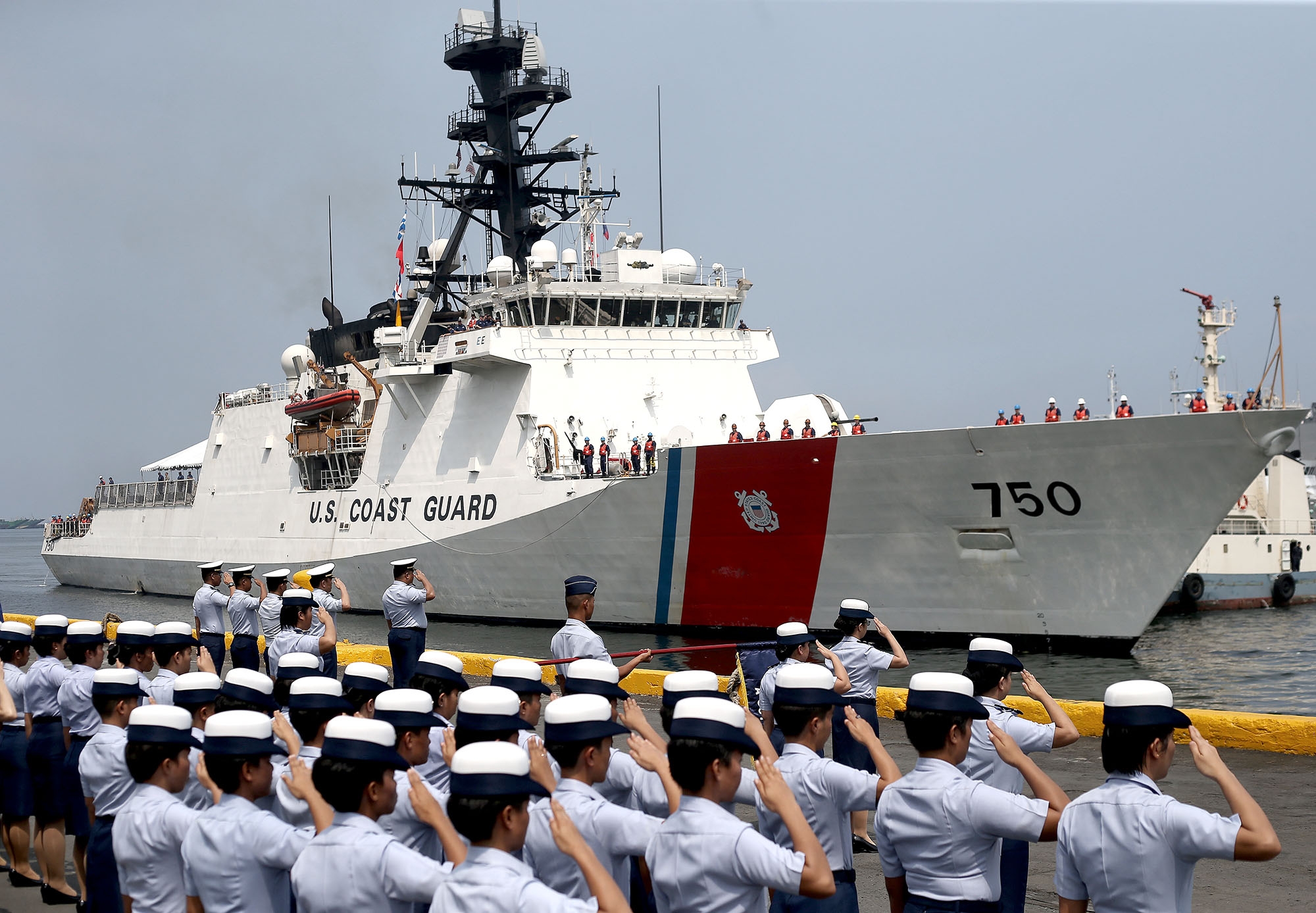
FIRST PORT CALL The US Coast Guard cutter Bertholf arrives at Manila South Harbor’s Pier 15 after participating in search-and-rescue and maritime security exercises with the Philippine Coast Guard near Panatag (Scarborough) Shoal. —RICHARD A. REYES
WEST PHILIPPINE SEA — With Chinese ships watching from a distance, Philippine and US Coast Guard vessels conducted drills near a disputed reef in the South China Sea on Tuesday, in the first civilian maritime exercises between the two Pacific allies in the heavily contested waterway.
The Philippine Coast Guard’s vessels BRP Batangas and BRP Kalanggaman engaged the US Coast Guard’s cutter Bertholf in capacity-building exercises near Panatag Shoal—known internationally as Scarborough Shoal—in the West Philippine Sea, 90 kilometers from Subic Bay in Zambales province.
China’s sweeping claim
West Philippine Sea is the local name of the waters within the Philippines’ 370-kilometer exclusive economic zone (EEZ) in the South China Sea.
It is not another name for the South China Sea, a strategic waterway nearly all of which is claimed by China, including waters within the EEZs of the Philippines, Brunei, Malaysia and Vietnam — all members of the Association of Southeast Asian Nations (Asean) whose navies conducted exercises with the US Navy off Singapore recently.
A UN-backed arbitral court in The Hague invalidated China’s sweeping claim in 2016, in the ruling on a challenge brought by the Philippines.
Beijing, however, ignored the ruling, insisting on ownership of nearly the entire sea, which is criss-crossed by sea-lanes where $5 trillion in global trade passes every year and where islets, atolls and reefs are believed to be sitting atop vast energy reserves.
As the Philippines has no military muscle to assert the arbitral ruling, the United States and its Western allies regularly conduct freedom of navigation operations through the South China Sea to show China that they do not recognize its claim.
The US Coast Guard’s exercises with the Philippine Coast Guard was likely a preview of a bigger role for it in the South China Sea.
“The US has [its] capacity to conduct maritime law enforcement and maritime security, and the Philippines has its own set of protocols to do the same. By working together, we learn from each other and develop working harmony involving mutual interest of both countries,” Cmdr. Gary Dale Gimotea, commanding officer of the Batangas, said aboard the vessel during the drills on Tuesday.
DAVID AND GOLIATH The 114-meter China Coast Guard ship Zhongguohaijing sails close to the Philippine Coast Guard’s BRP Kalanggaman, a 24-meter French-built patrol boat that joined two other PCG vessels and the US cutter Bertholf in search-and-rescue, maritime security and law enforcement exercises near the disputed Panatag (Scarborough) Shoal. —AFP
Just observing
Not far away, two Chinese Coast Guard vessels watched the exercises.
At one point, one of the Chinese vessels got as close as 5.4 km to the Batangas. The Chinese vessels, however, did not interact with the Philippine ship.
“They’re just trying to observe what we’re trying to do with the capability exercise involving the US Coast Guard,” Gimotea said.
The US Navy’s freedom of navigation operation, involving two warships, near Philippine-claimed Burgos (Gaven) and Mabini (Johnson South) reefs on Monday last week angered China, which said it “damaged the peace, security and good order of the relevant seas.”
Commenting on the Chinese reaction on Wednesday in Singapore, John Richardson, head of the US Navy’s operations, said the freedom of navigation operations got “more attention in the media and also have, sometimes from China, than they warrant, to be honest.”
‘No spikes’
In an earlier speech, Richardson said the US naval operations had been consistent over decades and had not risen recently.
“I’ve done the analysis and I can state with confidence that our level of operations has been consistent over the decades,” Richardson said, adding that there had been “no spikes recently.”
The maritime drills, which started on April 29, were cohosted by Singapore and South Korea.
The Philippine Navy’s patrol vessel BRP Andres Bonifacio joined 18 other warships, 10 aircraft and more than 1,500 personnel from the US and other navies in the region in exercises that ended on Monday.
Meanwhile, the US Coast Guard’s Bertholf made a port call in Manila on Wednesday, the first visit by a US Coast Guard vessel to the Philippine capital.
The ship is under the control of the US 7th Fleet for its Asia-Pacific deployment, but is normally under the Department of Homeland Security.
—Reports from Frances Mangosing, Jeannette I. Andrade and the wires